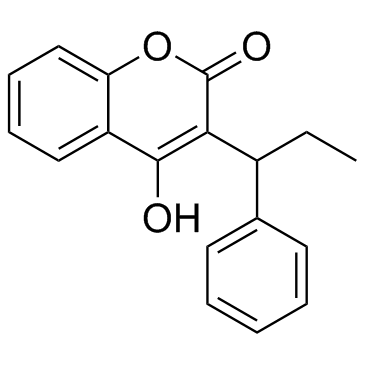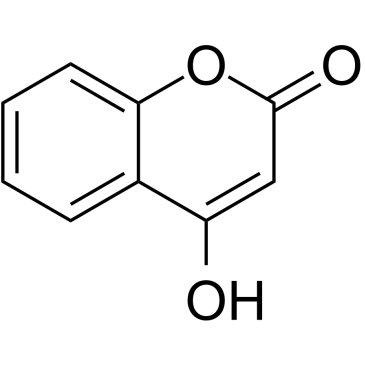435-97-2
| Name | phenprocoumon |
|---|---|
| Synonyms |
Marcoumar
Phenprocumon Marcumar 4-Hydroxy-3-(1-phenylpropyl)-2H-chromen-2-one UNII:Q08SIO485D Falithrom Falithiom Phenprocumone 3-(a-Ethylbenzyl)-4-hydroxycoumarin 2H-1-Benzopyran-2-one, 4-hydroxy-3-(1-phenylpropyl)- RO 1-4849 Fencumar LIQUAMAR PHENPROCOUMON |
| Description | Phenprocoumon is a coumarin derivative that acts as a long acting oral anticoagulant and an antagonist of vitamin K. |
|---|---|
| Related Catalog | |
| Target |
Vitamin K[1]. |
| In Vivo | After a single i.v.-dose of phenprocoumon (0.355 mg/kg) the anticoagulant effect obtained is greater in older than in younger rats. There are no differences between younger and older rats in the rate of elimination, volume of distribution and in the free fraction and free concentration values of phenprocoumon in plasma and liver. After i.v.-injection of 64.3 μg/kg [3H]vitamin K1 and different doses of phenprocoumon (0.02 to 3 mg/kg) the [3H]vitamin K1 concentration in the liver decreases and the [3H] vitamin K1-2, 3-epoxide concentration increases dependent on the dose and the liver concentration of phenprocoumon. These changes are more pronounced in the older than in the younger rats[2]. |
| References |
| Density | 1.3±0.1 g/cm3 |
|---|---|
| Boiling Point | 463.2±45.0 °C at 760 mmHg |
| Melting Point | 179.5ºC |
| Molecular Formula | C18H16O3 |
| Molecular Weight | 280.318 |
| Flash Point | 195.7±21.5 °C |
| Exact Mass | 280.109955 |
| PSA | 50.44000 |
| LogP | 4.77 |
| Vapour Pressure | 0.0±1.2 mmHg at 25°C |
| Index of Refraction | 1.638 |
| Storage condition | 2-8℃ |
CHEMICAL IDENTIFICATION
HEALTH HAZARD DATAACUTE TOXICITY DATA
|
| RIDADR | UN 2811 |
|---|---|
| Packaging Group | III |
| Hazard Class | 6.1(b) |
| HS Code | 2932209090 |
|
~95% 
435-97-2 |
| Literature: Kischel, Jette; Mertins, Kristin; Michalik, Dirk; Zapf, Alexander; Beller, Matthias Advanced Synthesis and Catalysis, 2007 , vol. 349, # 6 p. 865 - 870 |
| HS Code | 2932209090 |
|---|---|
| Summary | 2932209090. other lactones. VAT:17.0%. Tax rebate rate:13.0%. . MFN tariff:6.5%. General tariff:20.0% |

